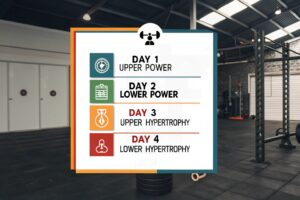Looking for a proven routine that consistently builds muscle, burns fat, and fits a busy schedule? The 4‑Day Upper/Lower Split That Guarantees Consistent Gains is the answer. By alternating upper‑body and lower‑body sessions across four training days, you’ll hit each muscle group with optimal frequency, volume, and intensity while allowing ample recovery. This guide breaks down why this split works, how to structure every workout, and the exact progressive overload strategies you need to keep the plates moving upward week after week.
The beauty of the 4‑Day Upper/Lower split lies in its flexibility. Whether you’re a seasoned lifter aiming to break a plateau or a beginner craving clear, science‑based programming, this routine adapts to any training experience. You’ll learn how to balance compound power moves with targeted isolation work, how to manipulate tempo and rest intervals for maximal hypertrophy, and how to integrate cardio and mobility without sacrificing muscle growth.
In the sections that follow we’ll dive deep into program design, weekly templates, exercise selection, progressive overload, recovery, nutrition, and troubleshooting. By the end, you’ll have a fully fleshed‑out plan that you can copy‑paste into your calendar and start seeing measurable improvements within the first four weeks.
The Science Behind the Upper/Lower Split (Why It Works for Consistent Gains)
Frequency vs. Volume: Finding the Sweet Spot
Research consistently shows that training each muscle group 2‑3 times per week yields greater hypertrophy than once‑per‑week routines, provided total weekly volume is matched. The 4‑Day Upper/Lower split delivers exactly that—each major muscle group is stimulated twice per week, allowing you to accumulate sufficient mechanical tension while keeping sessions under 90 minutes. This frequency promotes protein synthesis peaks that last roughly 48‑72 hours, ensuring you’re always “on” the anabolic side of the equation.
Recovery Optimization Through Alternating Muscle Groups
Because upper‑body days are followed by lower‑body days, you give each region at least 48 hours of rest before it’s trained again. This layout reduces systemic fatigue compared to full‑body workouts that tax the entire nervous system in a single session. Additionally, moving from squat‑heavy to bench‑heavy days distributes metabolic stress, minimizing the risk of overtraining and enabling you to lift heavier on every set.
Adaptability for All Training Levels
Beginners can start with lighter loads, higher reps, and simpler accessory work while still respecting the split’s core principle of upper‑lower alternation. Intermediate lifters can add volume through supersets or drop sets. Advanced athletes can incorporate strength‑focused blocks (e.g., 5×5) on one week and hypertrophy‑focused blocks (e.g., 3×12) the next, all within the same 4‑day framework. This scalability makes the split a lifelong tool rather than a temporary program.
Weekly Blueprint: Sample 4‑Day Upper/Lower Schedule (Great Keyword)

Day 1 – Upper Body Power
Primary lifts: Barbell Bench Press 4×5, Bent‑Over Row 4×5, Overhead Press 3×6.
Accessory: Incline Dumbbell Flyes 3×12, Face Pulls 3×15, Triceps Rope Pushdowns 3×12.
Core: Weighted Plank 3×30‑seconds.
This day focuses on low‑rep, high‑intensity work to build foundational strength. Rest intervals are 2‑3 minutes between main sets to fully recover the nervous system.
Day 2 – Lower Body Power
Primary lifts: Back Squat 4×5, Deadlift 3×5, Walking Lunges 3×10 each leg.
Accessory: Leg Curl 3×12, Calf Raises 4×15, Hip Thrusts 3×12.
Core: Hanging Leg Raises 3×12.
Like Day 1, the emphasis is on heavy compound movement with ample rest (2‑3 minutes). The accessory exercises address posterior‑chain development and ankle stability, which are critical for power output.
Day 3 – Upper Body Hypertrophy
Primary lifts: Incline Bench Press 3×10, Seated Cable Row 3×10, Dumbbell Lateral Raises 4×12.
Accessory: Chest‑Supported DB Row 3×12, EZ‑Bar Curls 3×12, Overhead Triceps Extension 3×12.
Core: Russian Twists with Medicine Ball 3×20.
Higher rep range (8‑12) with moderate weight promotes metabolic stress and muscle pump. Rest intervals are trimmed to 60‑90 seconds to boost time‑under‑tension.
Day 4 – Lower Body Hypertrophy
Primary lifts: Front Squat 3×10, Romanian Deadlift 3×10, Bulgarian Split Squat 3×12 each leg.
Accessory: Leg Press 3×15, Seated Calf Raise 4×15, Glute‑Bridge March 3×20.
Core: Cable Woodchoppers 3×15 each side.
Similar to Day 3, this session utilizes moderate loads and shorter rests (60‑90 seconds) to maximize sarcoplasmic expansion while still delivering enough mechanical tension for strength maintenance.
Progressive Overload Strategies for the 4‑Day Split (Great Keyword)
Linear Progression: The Classic “Add‑5‑Pounds” Rule
For the first 4‑6 weeks, aim to increase the weight on your main lifts by 2.5‑5 lb (1‑2 kg) each session, provided you can complete all prescribed reps with proper form. This simple approach builds a solid strength base and trains your nervous system to handle heavier loads without overwhelming your recovery capacity.
Undulating (Daily) Periodization: Mixing Rep Ranges
After you’ve saturated linear gains, switch to an undulating model where you rotate rep schemes each week: Week 1 – 5‑5‑5, Week 2 – 8‑10‑12, Week 3 – 4‑6‑8. This variation prevents adaptation, stimulates different muscle‑fiber types, and maintains continual stress on the musculoskeletal system, ensuring “consistent gains” even at advanced stages.
Volume‑Based Overload: Adding Sets or Reps
When you reach a weight plateau, add an extra set to a key compound or increase the rep count by 1‑2 on each set before raising the load again. For example, progress from 4×5 to 5×5 on the bench press, or from 8‑10 reps to 10‑12 reps. This method respects the principle of progressive overload while mitigating excessive central fatigue.
Nutrition Blueprint to Fuel the 4‑Day Upper/Lower Split (Great Keyword)
Calorie Targets: Surplus vs. Maintenance
If your primary goal is muscle gain, aim for a modest caloric surplus of 250‑500 kcal above your maintenance level. Use a reputable TDEE calculator, then adjust based on weekly weight changes (0.5‑1 lb per week is ideal). For those focusing on recomposition, a maintenance or slight surplus (100‑200 kcal) paired with high protein intake can still produce net muscle growth while trimming fat.
Macro Ratios: Prioritize Protein, Balance Carbs & Fats
Protein should be the cornerstone: 1.0‑1.2 g per pound of bodyweight (2.2‑2.6 g/kg) spread across 4‑5 meals to sustain muscle‑protein synthesis. Carbohydrates supply the energy needed for heavy lifts—target 2‑3 g per pound (4.4‑6.6 g/kg) on training days, slightly lower on rest days. Healthy fats (0.3‑0.4 g per pound) support hormone production and joint health.
Meal Timing & Supplementation
Consume a balanced pre‑workout meal (30‑60 g carbs, 15‑20 g protein) 60‑90 minutes pre‑session. Post‑workout, prioritize a fast‑acting protein source (whey or plant‑based blend) with 20‑30 g carbs within 30‑45 minutes to replenish glycogen and kick‑start recovery. Optional supplements that complement this split include creatine monohydrate (5 g daily), beta‑alanine (3‑4 g), and a high‑quality multivitamin.
Common Pitfalls & How to Troubleshoot Them (Great Keyword)
Overtraining: Signs, Prevention, and Recovery
Even with a well‑balanced 4‑Day split, some lifters push volume or intensity too aggressively. Watch for persistent soreness beyond 48 hours, declining performance, disturbed sleep, and elevated resting heart rate. If these appear, deload by reducing volume 40‑50 % for a week, focus on mobility work, and ensure you’re getting 7‑9 hours of sleep nightly.
Plateaued Strength: Why It Happens and What to Do
Plateaus often stem from stagnant rep schemes or insufficient progressive overload. Rotate the main lifts every 4‑6 weeks (e.g., swap bench press for close‑grip press, switch front squats to pause squats). Incorporate reverse‑band or chain work to improve lock‑out strength. Also, reassess sleep, stress, and micronutrient intake; deficiencies can blunt progress.
Imbalanced Development: Avoiding Upper/Lower Discrepancies
If you notice one limb or region lagging, add unilateral accessories (single‑arm dumbbell press, single‑leg Romanian deadlifts) on the weaker side. Prioritize “pre‑exhaust” techniques—perform a high‑rep isolation set before the compound to activate under‑recruited muscles. This ensures balanced hypertrophy across the whole body, keeping the split truly “upper‑lower”.
Wrap‑Up: Implementing The 4‑Day Upper/Lower Split for Lifetime Gains
The 4‑Day Upper/Lower Split That Guarantees Consistent Gains is more than a workout template; it’s a holistic system that blends science‑backed training frequency, progressive overload, recovery optimization, and targeted nutrition. By following the weekly blueprint, applying the overload strategies, and staying vigilant about nutrition and recovery, you’ll create a sustainable path to steady muscle growth, enhanced strength, and improved body composition.
Start today—log your first week, track your lifts, and adjust the program based on your personal feedback. Consistency, patience, and intelligent tweaking are the real keys to unlocking the promised gains. Happy lifting!



